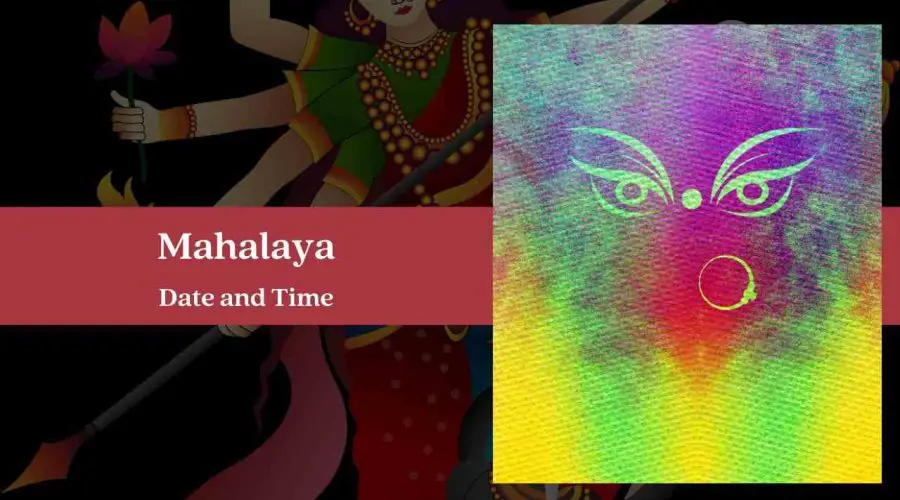Mahalaya 2023 (Durg Puja): Date, Time, Rituals, and Significance
Article Rating
☆☆☆☆☆ 3.9/5
On the Amavasya day of the Hindu month of Ashwin or Ashwayuja, Mahalaya is observed (September-October). On Mahalaya day, the last day of the Pitru Paksha fortnight, the sacred period for performing rituals and presenting oblations to the souls of deceased ancestors, comes to an end. On Mahalaya day, the Durga Puja rites begin.
On Mahalaya day, ceremonies and rites are performed early in the morning on riverbanks or along the seaside. Food is the primary offering presented to ancestors on Mahalaya Paksha. It is thought that the offerings offered during this time will help all of the souls who have passed on. People also donate food as a form of charity.
Mahalaya 2023 Date
The date for Mahalaya 2023 is Saturday, October 14. On October 14, the time will be 9:29 PM on October 13 to 10:54 PM.
Mahalaya – Durga Puja
Mahalaya also announces Goddess Durga’s arrival on Earth. The beginning of ‘Devipaksha’ and the countdown to Durga Puja is marked by Mahalaya. Goddess Durga, together with her family, is invited to descend to the ground on Mahalaya day. Goddess Saraswati and Goddess Lakshmi are regarded members of Durga’s family in Bengal.
Goddess Durga, together with her family, is invited to descend to the ground on Mahalaya day. Goddess Saraswati and Goddess Lakshmi are regarded members of Durga’s family in Bengal.
Rituals of Mahalaya 2023
- Family members of the deceased perform tarpan, a ritual in which an offering is made to the ancestors, on the last day of Pitripaksha. Tarpan is only conducted after a holy dip in the Gange or another body of water.
- For the people of West Bengal, Mahalaya has a unique meaning. People get up early on this day to make all the necessary preparations to welcome Goddess Durga into their houses.
- On the day of Mahalaya, one of the Durga Puja customs that Bengalis have observed for 90 years is listening to the Mahishasuramardini composition.
Significance of Mahalaya
According to Hindu mythology, the festival commemorates Goddess Durga’s return to her birthplace with her offspring. Mahalaya, which commemorates the start of Durga’s trip to her house, precedes Durga Puja. The puja itself begins on “Maha Sashthi,” or the sixth day, when devotees greet the Goddess with grandeur and fervour. Durga’s deity is exposed in front of the public on this day.
Several rituals are conducted, and the “dhakis” play the “dhak,” a type of drum linked with the puja and Bengali culture, to keep the atmosphere and spirit of the puja alive.
The “Maha Saptami” festival begins on the seventh day. As part of the rite, a banana tree is immersed in water just before dawn on this day. Following the ceremonial wash, the tree, or “Kola Bou” (as it is known in Bengali), is draped in a saree, generally a red-bordered one, and placed on Ganesha’s right side, signifying that “Kola Bou” is Ganesha’s bride. Several cultural revisionists and historians, on the other hand, have opposing viewpoints, with some believing that “Kola Bou” is another portrayal of Durga. As a result, they disprove the belief that “Kola Bou” is Ganesha’s bride.
Another viewpoint is that “Kola Bou” is a sign for nine diverse plant species that constitute a sacred compound. Before executing the rite, priests tie a bundle of eight plants to the banyan tree’s trunk. The nine diverse leaves unite to form “Kola Bou,” which is sometimes referred to as Durga’s plant form.
Frequently Asked Questions
1. What is the importance of Mahalaya?
Mahalaya commemorates Goddess Durga’s victory over the monster Mahishasura. Pitripaksha, commonly known as the Forefathers’ Fortnight, comes to a close on this day. Hindus pay tribute to their forefathers and mothers during these 16 days. For the Bengali community, this is the start of Durga Puja.
2. What Mahalaya means?
Mahalaya (Bengali: ) usually signifies the start of Durga Puja celebrations in Bengal. The goddess Durga is said to have descended to Earth on the day of Mahalaya. On Mahalaya, Bengalis customarily rise early in the morning to chant hymns from the Devi Mahatmya (Chandi) text.
3. Is Mahalaya a holy day?
Bengalis have a unique tradition of waking up at 4 a.m. on Mahalaya Day to listen to Birendra Krishna Bhadra recite the sacred lines of ‘Mahisasura Mardini.’ The account of Goddess Durga’s descent on earth is told in brief verses in the holy scriptures.
4. Is Mahalaya related to Durga Puja?
Mahalaya is observed by Goddess Durga followers a week before Durga Puja celebrations. Mahalaya, according to the Hindu calendar, is the last day of Pitru Paksha, which is today, October 6th. They created Goddess Durga to use her heavenly abilities to vanquish the demon King Mahishasura.
5. Why does Durga have 10 arms?
Lord Durga’s ten arms represent her protection of her worshippers from all directions, including the eight corners, the sky, and the ground. Lord Durga’s ten arms represent her protection of her worshippers from all directions, including the eight corners, the sky, and the ground.

